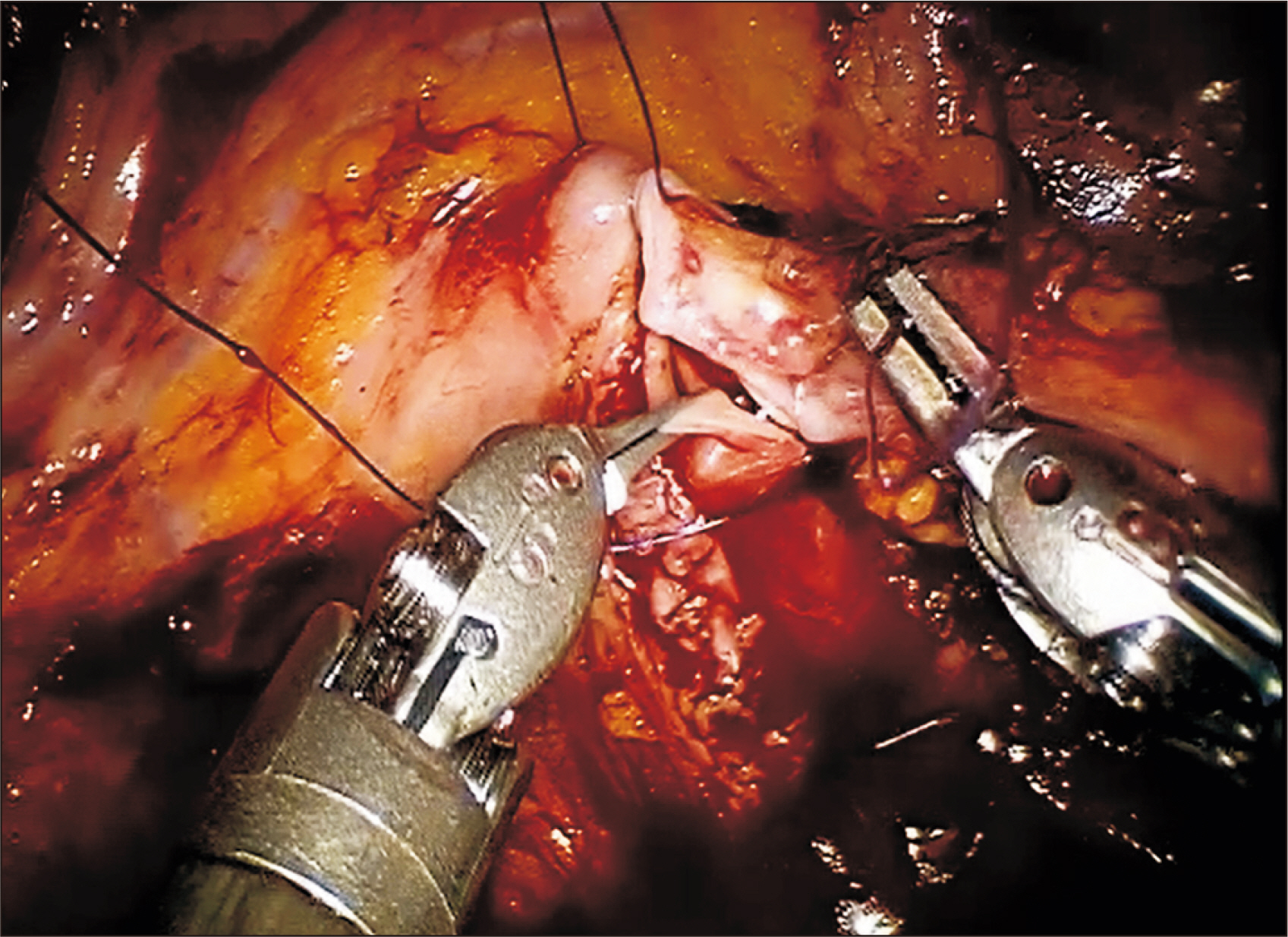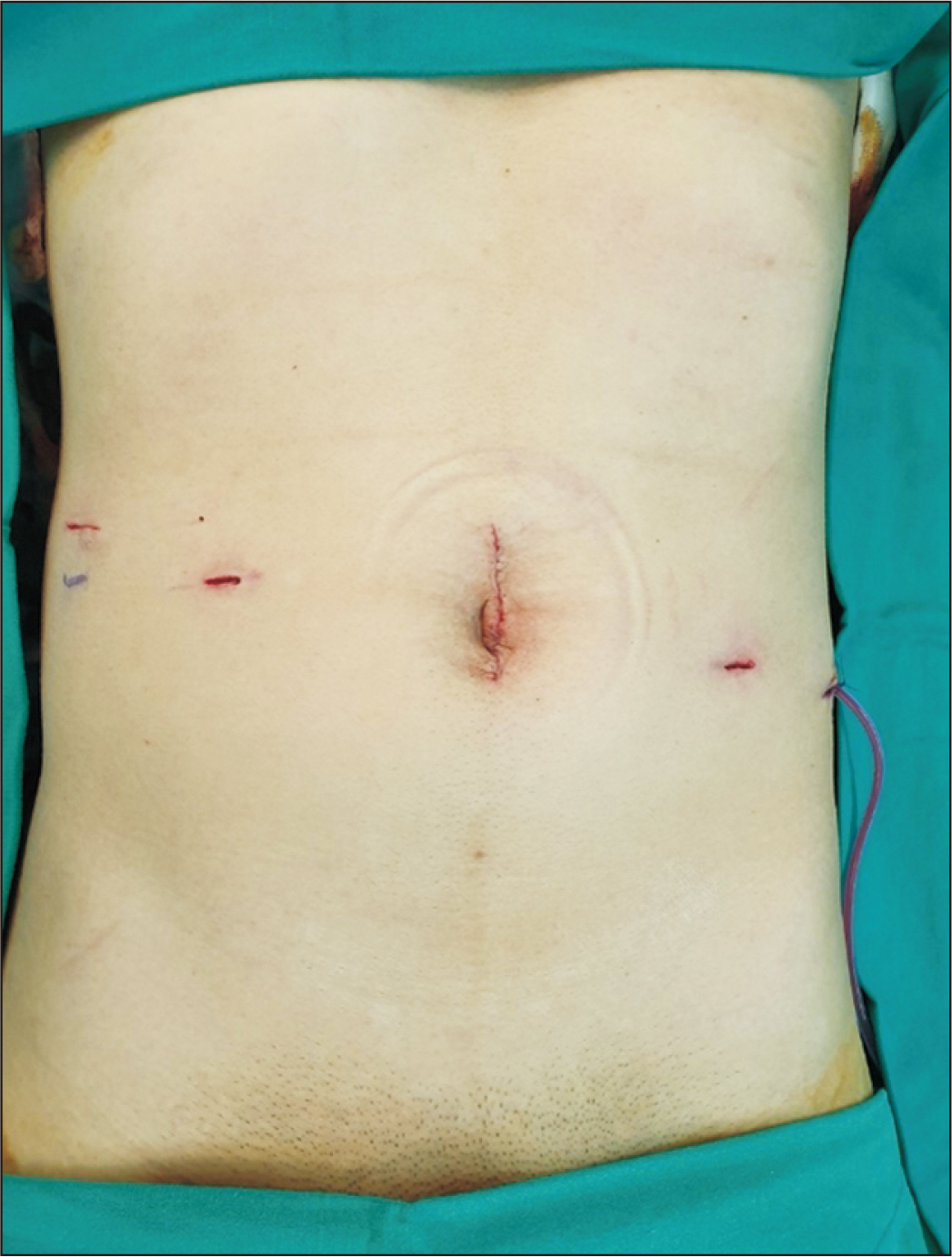Korean J Transplant.
2022 Mar;36(1):61-66. 10.4285/kjt.21.0023.
The first robotic kidney transplantation in Korea: a case report
- Affiliations
-
- 1Department of Surgery, Yonsei University College of Medicine, Seoul, Korea
- 2Department of Surgery, CHA Bundang Medical Center, CHA University School of Medicine, Seongnam, Korea
- 3Vattikuti Urology Institute, Henry Ford Hospital, Detroit, MI, USA
- 4Department of Urology, Yonsei University College of Medicine, Seoul, Korea
- KMID: 2527899
- DOI: http://doi.org/10.4285/kjt.21.0023
Abstract
- Minimally invasive surgery reduces perioperative pain and morbidity, facilitating rapid recovery. However, the field of kidney transplantation has lagged in this regard, its customary open surgical techniques going nearly unchanged until recently. Robotic kidney transplantation (RKT) is a novel and welcomed innovation yielding good surgical outcomes. In Korea, the first RKT performed (November 2019) involved a 30-year-old man (body mass index, 22 kg/m2 ) with end-stage hypertensive nephrosclerosis. A left donor kidney from his 28-year-old sister was successfully transplanted using the daVinci Robotic Surgical System. Transperitoneal regional hypothermia (Vattikuti Urology Institute-Medanta technique) was also implemented across the main periumbilical incision (up to 6 cm). Total operative time was 260 minutes (cold ischemia, 34 minutes; rewarming, 54 minutes), with 50 mL of blood loss. There was immediate graft function, unencumbered by surgical complications (e.g., postoperative bleeding, leakage, or lymphocele). The patient was discharged on postoperative day 8, with serum creatinine at 1.27 mg/dL. RKT with regional hypothermia may be a viable, minimally invasive intervention that is safe and effective in select patients, showing good surgical results.
Figure
Reference
-
1. Pein U, Girndt M, Markau S, Fritz A, Breda A, Stöckle M, et al. 2020; Minimally invasive robotic versus conventional open living donor kidney transplantation. World J Urol. 38:795–802. DOI: 10.1007/s00345-019-02814-7. PMID: 31127330.
Article2. Ahlawat R, Sood A, Jeong W, Ghosh P, Keeley J, Abdollah F, et al. 2021; Robotic kidney transplantation with regional hypothermia versus open kidney transplantation for patients with end stage renal disease: an ideal stage 2B study. J Urol. 205:595–602. DOI: 10.1097/JU.0000000000001368. PMID: 32941100.
Article3. Hameed AM, Yao J, Allen RD, Hawthorne WJ, Pleass HC, Lau H. 2018; The evolution of kidney transplantation surgery into the robotic era and its prospects for obese recipients. Transplantation. 102:1650–65. DOI: 10.1097/TP.0000000000002328. PMID: 29916987.
Article4. Bruyère F, Doumerc N. 2018; Robotic kidney transplantation: dream or future? Curr Opin Urol. 28:139–42. DOI: 10.1097/MOU.0000000000000476. PMID: 29303915.5. Ahlawat RK, Tugcu V, Arora S, Wong P, Sood A, Jeong W, et al. 2018; Learning curves and timing of surgical trials: robotic kidney transplantation with regional hypothermia. J Endourol. 32:1160–5. DOI: 10.1089/end.2017.0697. PMID: 29587531.
Article6. Menon M, Abaza R, Sood A, Ahlawat R, Ghani KR, Jeong W, et al. 2014; Robotic kidney transplantation with regional hypothermia: evolution of a novel procedure utilizing the IDEAL guidelines (IDEAL phase 0 and 1). Eur Urol. 65:1001–9. DOI: 10.1016/j.eururo.2013.11.011. PMID: 24287316.
Article7. Menon M, Tewari A, Peabody J. VIP Team. 2003; Vattikuti Institute prostatectomy: technique. J Urol. 169:2289–92. DOI: 10.1097/01.ju.0000067464.53313.dd. PMID: 12771773.
Article8. Riedmiller H, Gerharz EW. 2008; Antireflux surgery: Lich-Gregoir extravesical ureteric tunnelling. BJU Int. 101:1467–82. DOI: 10.1111/j.1464-410X.2008.07683.x. PMID: 18454801.
Article9. Diana M, Marescaux J. 2015; Robotic surgery. Br J Surg. 102:e15–28. DOI: 10.1002/bjs.9711. PMID: 25627128.
Article10. Modi P, Pal B, Modi J, Kumar S, Sood A, Menon M. 2014; Robotic assisted kidney transplantation. Indian J Urol. 30:287–92. DOI: 10.4103/0970-1591.135669. PMID: 25097315. PMCID: PMC4120216.
Article11. Nataraj SA, Zafar FA, Ghosh P, Ahlawat R. 2020; Feasibility and functional outcome of robotic assisted kidney transplantation using grafts with multiple vessels: comparison to propensity matched contemporary open kidney transplants cohort. Front Surg. 7:51. DOI: 10.3389/fsurg.2020.00051. PMID: 33195380. PMCID: PMC7477351.
Article12. Tzvetanov I, DʼAmico G, Benedetti E. 2015; Robotic-assisted kidney transplantation: our experience and literature review. Curr Transplant Rep. 2:122–6. DOI: 10.1007/s40472-015-0051-z. PMID: 26000230. PMCID: PMC4431703.
Article13. Hoznek A, Zaki SK, Samadi DB, Salomon L, Lobontiu A, Lang P, et al. 2002; Robotic assisted kidney transplantation: an initial experience. J Urol. 167:1604–6. DOI: 10.1016/S0022-5347(05)65162-2. PMID: 11912372.
Article14. Giulianotti P, Gorodner V, Sbrana F, Tzvetanov I, Jeon H, Bianco F, et al. 2010; Robotic transabdominal kidney transplantation in a morbidly obese patient. Am J Transplant. 10:1478–82. DOI: 10.1111/j.1600-6143.2010.03116.x. PMID: 20486912.
Article15. Menon M, Sood A, Bhandari M, Kher V, Ghosh P, Abaza R, et al. 2014; Robotic kidney transplantation with regional hypothermia: a step-by-step description of the Vattikuti Urology Institute-Medanta technique (IDEAL phase 2a). Eur Urol. 65:991–1000. DOI: 10.1016/j.eururo.2013.12.006. PMID: 24388099.
Article
- Full Text Links
- Actions
-
Cited
- CITED
-
- Close
- Share
- Similar articles
-
- Visualizing kidney transplant techniques: a comparative study of open and robotic surgery
- Current status of robotic surgery for liver transplantation
- Surgical techniques for robotic right donor hepatectomy, part 2: robotic parenchymal transection and bile duct division
- Experience of robotic assisted living donor nephrectomy at Cho Ray Hospital - the single institution in Vietnam
- Ureteroneocystostomy in Kidney Transplantation with Ureteral Duplication: A Case Report







